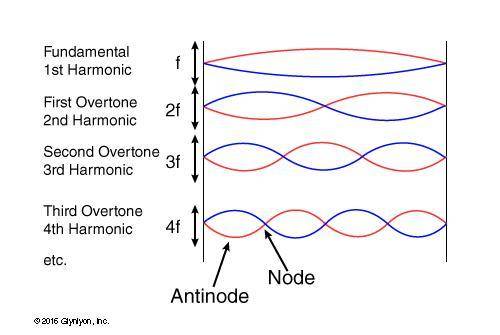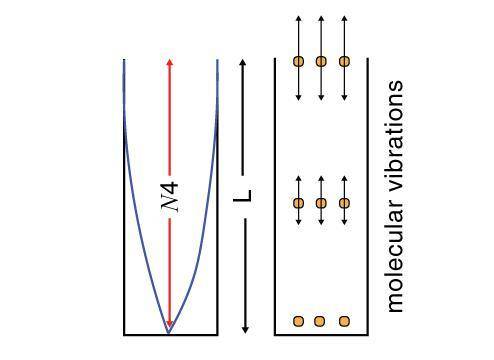
Physics, 03.11.2020 07:10 kaylaschauman8660
EXPERIMENT: USING VIBRATIONS TO PRODUCE SOUND
When a wave fits perfectly within boundary conditions, it will resonate. That is, a series of waves will reflect and interfere with each other to make a standing wave. When this happens with a sound wave, the result at the open end of the tube is much louder than the sound that makes the original wave. At the open end of the tube there will be constructive interference.
In this diagram you see what standing waves on a string look like when the two ends are fixed, like on a guitar or a violin. Standing waves only occur when the wavelength is just right and there are nodes at the locations where the string is unable to move. The top picture represents ½ of a wave fitting within the boundaries. The second picture represents exactly 1 wave fitting within the boundaries. The third and fourth pictures represent 3/2 of a wave and 2 waves fitting within the boundaries.
Assignment Directions
Safety
There are no safety considerations as the data shall be taken from an actual experiment performed on video.
Materials
The experiment will take place using 8 tuning forks, a rubber mallet, a glass tube, a large graduated cylinder or other container filled with water, and a meter stick.
Procedure
Steps 1-3 will be completed on the video. You will determine the length of the tube in step four by watching the video and reading the meter stick.
The glass tube shall be held upright in water with most of the tube submerged.
A tuning fork with a frequency of 512 Hz will be struck with a mallet so it vibrates properly.
While holding the tuning fork vertically just over the open end of the glass tube, the tube should be raised until the resonating sound of the tuning fork can be heard throughout the room.
While the resonating sound is present, the length of the glass tube from the water level to the top should be measured with a meter stick to the nearest millimeter.
The data should be recorded on the data table. The frequency comes from the tuning fork. The wavelength is 4 times the length of the tube above the water. Make sure you record the wavelength in meters. (See the introduction if you are not sure why you are multiplying the length of the tube by 4.)
Repeat the experiment with 7 more tuning forks at their given frequencies.
SHOW TRANSCRIPT
Questions
Complete the data table using the procedure above and the video provided.
Using the equation v = fƛ, determine the wave speed for each trial.
Determine an average wave speed by averaging the wave speeds you found for each trial.
To calculate the exact value for the speed of sound, use the temperature given at the beginning of the video and the following equation: Vsound = 331 m/s + 0.6(TCelcius)
How close was your average speed to the calculation of the actual value for the speed of sound in m/s? Give 2 examples of errors that may have occurred during the lab that could have caused your value to be different than the value that you determined using the equation.
Submission Requirements
To fully complete this project, you will submit the following:
Complete the data table with values that you determine from the video and calculated.
Find the average wave speed as asked for in question 3.
Find the mathematical speed of sound as asked for in question 4. Show your calculation.
Answer to question 5 above in complete sentences.



Answers: 2
Another question on Physics

Physics, 21.06.2019 23:30
Jessie ran 5000 meters from the cops and an average speed of 6 meters / second before he got caught . how long did he run?
Answers: 1

Physics, 22.06.2019 14:40
You throw a small rock straight up from the edge of a highway bridge that crosses a river. the rock passes you on its way down, 7.00 s after it was thrown. what is the speed of the rock just before it reaches the water 28.0 m below the point where the rock left your hand? ignore air resistance.
Answers: 2

Physics, 22.06.2019 15:00
A10 kg box initially at rest is pulled 18 meters across a horizontal, frictionless surface by a 40 n force. what is the block’s final velocity over the 18 meters?
Answers: 2

You know the right answer?
EXPERIMENT: USING VIBRATIONS TO PRODUCE SOUND
When a wave fits perfectly within boundary conditions...
Questions

Physics, 13.07.2019 20:00

History, 13.07.2019 20:00

Social Studies, 13.07.2019 20:00


Mathematics, 13.07.2019 20:00

Mathematics, 13.07.2019 20:00


Social Studies, 13.07.2019 20:00




Mathematics, 13.07.2019 20:00




Computers and Technology, 13.07.2019 20:00


History, 13.07.2019 20:00

English, 13.07.2019 20:00

History, 13.07.2019 20:00



